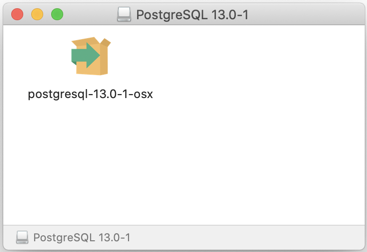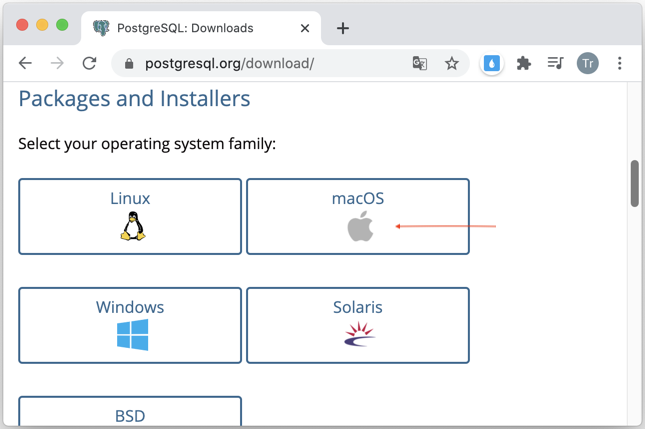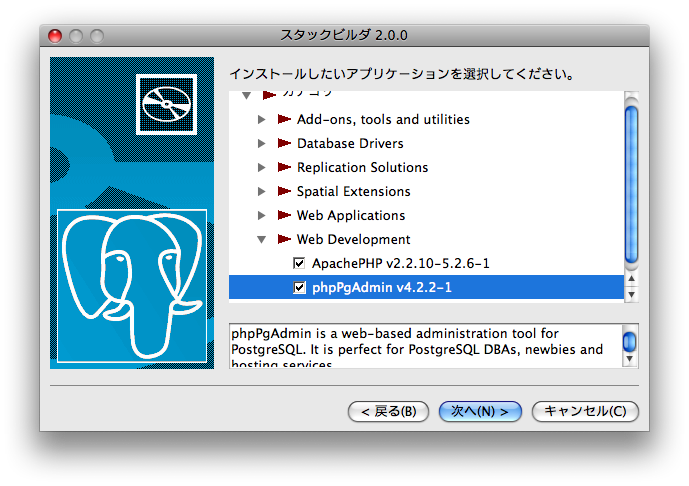
A window will appear with the two sets of environment variables. Go to the Control Panel > System and Security > System and select Advanced system settings.įrom there you'll see a box called System Properties. After it installs, you'll need to set up your Windows environment variables so that you can use the psql client in the command prompt. Select only the "Command Line Tools" because we don't need the server installed. Once the executable file is downloaded, run it and you'll see the following options:
#POSTGRESQL MAC WINDOWS 10#
Click on that link and select PostgreSQL 9.6 or 10 and Windows 10 as the platform.
#POSTGRESQL MAC INSTALL#
It's a full installation package for PostgreSQL on Windows but you can set it to only install the command line tools like psql. We currently recommend using the PostgreSQL installer from Enterprise DB. On Windows 10, there's a bit more work to be done. So For Fedora 27 and 28 and later, install the PostgreSQL client from the terminal with: sudo dnf install postgresql.x86_64Īnd that's all you need to do. Fedora 27 and 28įedora's default repositories already have a PostgreSQL client available from them. If you are wondering where to find that repository URL, head to Linux Downloads (Red Hat Family) where you'll find a form which will let you select the PostgreSQL version, platform and architecture and it'll give you the appropriate instructions for that Red Hat variant - that includes CentOS, Scientific Linux, and Oracle Enterprise Linux. With that done, you can add packages from it by name: sudo yum install postgresql10 Yum goes to that URL and configures itself to use that package repository. First, you need to point yum at the PostgreSQL repository like this: sudo yum install Red Hat Enterprise Linux 7 (and others)įor Red Hat Enterprise Linux (or RHEL as it's usually written), there's a little more set up to do than Ubuntu. This will install the PostgreSQL 10 client, which can happily connect to earlier versions of PostgreSQL. The PostgreSQL client is distributed in the appositely named postgresql-client so all you need to do is run: sudo apt-get install postgresql-client For Ubuntu (and Debian-based distributions) thats's the apt command.

Linux systems, unlike macOS, have a package manager built in. You're ready to run psql and start connecting now. Which will symlink all the tools, not just libpq, into the /usr/local/bin directory. To make that happen, you need to run: brew link -force libpq There's a small catch though: libpq won't install itself in the /usr/local/bin directory. Brew makes it easy to install: brew install libpq Homebrew's package for the PostgreSQL client tools is the libpq package. With Homebrew in place you'll be able to install numerous applications, usually with the programs available in /usr/local/bin. We recommend Homebrew as a package manager for macOS. Red Hat Enterprise Linux 7 (and others).So, in this PostgreSQL Tip, we'll look at how you can install just psql on Windows, Linux and macOS, allowing you to quickly get up and running and connected to your Compose PostgreSQL service. It's a reasonable assumption if you're dealing with users who don't have access to PostgreSQL in the cloud or on a remote server. Most instructions for installing the PostgreSQL tools assume you want the database installed too. Why install all of PostgreSQL when your database server is up in the cloud, managed like a Compose PostgreSQL.
#POSTGRESQL MAC HOW TO#
Today's tip is how to have a lean mean PostgreSQL client machine by only installing the needed tools.



#POSTGRESQL MAC TRIAL#
PostgreSQL Tips: Installing the PostgreSQL Client postgresql postgresql tips Free 30 Day Trial


 0 kommentar(er)
0 kommentar(er)
